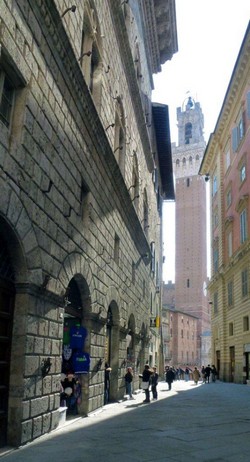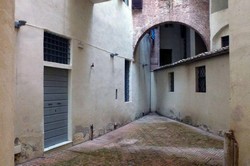Introduction
Only recently the subjects of this note have entered the history of playing cards: I can provide only two references about them, and both belong to previous notes of mine. I first found the "attribute" of Le Corone (the crowns) recorded in association to naibi in lists of goods sold by Puri mercers in the Autumn of 1447.(1)
In a second note, I have discussed various attributes found together with naibi, and I did not forget to mention Le Corone as a particular kind of fini cards, in which the improvement with respect to ordinary cards could be connected with the crowns of Kings and possibly Queens of the card suits.(2) Let me just repeat what I have written there, only a few days ago. «Le chorone. It seems that this attribute corresponded to the smallest contribution of gold to the painting. These were not gilded cards: gold paint (or foil) was only applied to the crowns of the personages. This small change was enough to remarkably increase the price of the pack.»
Now, I have found another record that may distrust my previous interpretation right away.
The game of Le Corone
I am at present performing a study on the Statuti of the Siena territory. Siena has been independent of Florence till 1555 and the corresponding early Statuti are mostly kept in Archivio di Stato di Siena (ASSi), which occupies part of the renowned Palazzo Piccolomini, near Piazza del Campo.(3)
In one of these Statuti, that of Massa Marittima(4), I encountered again Le Corone, in the different context of gambling prohibitions. Nothing exists to prove that the attribute found in Florence for playing cards has any connection with the game designated with the same name, forbidden in Massa.
Let us examine the Massa case. This Statuto is dated 1419 and, as in most Statuti, we find a chapter, on leaves 107v and 108r, devoted to prohibitions of gambling. We can read here the "usual" laws, with some names of forbidden dice and table games; moreover, backgammon and chess (tabulas et schaccos) are mentioned as exceptions.
Particularly interesting for us is however a subsequent law, contained in a Riforma dated 23 March 1445 (l. 128r). It is a whole Riforma devoted just to gambling. On its turn, this law is divided into a few paragraphs, one of which is precisely titled Le Corone, as marked on the edge of the page.
The whole text is written in Latin, except for the name itself of the game, which, as often occurs, keeps its Italian name of everyday use. I cannot guarantee that my reading is correct, but any mistake should not change the overall meaning too much.
| «Item statuerunt et ordinaverunt ne fiant joci sive ludi indecentes quod de cetero nulla persona masculus vel femina, magnus vel parvus, faciat ludum sive jocum qui dicitur le corone ad penam librarum quinque denariis pro quolibet qui ad dictum ludum interesset sive actinet. Et predicta pena solvenda pater et mater teneantur pro filio vel filia et proximiores consanguinei (pre?) vel matre deficienti teneantur pro consanguino vel consanguinea. Et quod domini priores qui pro tempore erunt et residebunt de mensis juni quolibet anno venendo (in mandato?) per octo dies ante festum sancti johannis baptiste teneant et debeant publice in locis consuetis bannire facere quod non fiant dicte corone ad dictam penam per quolibet contrafaciente.»
|
Discussion
We have thus two different occurrences of Le Corone: in Florence as an attribute of naibi, in Massa Marittima as the name of a game to which a whole paragraph of the laws was specifically dedicated. Now, it is our task to examine if a relation may exist between these two cases, and which it can be. No suggestion about it can as yet be found in the documents.
As for the Florentine cards, I must confess that my first impression had been that a kind of brand was already in use: later on, centuries later on, it was common to find cards mentioned with similar terms that the maker had adopted as a brand of his manufacture. Was it possible that a similar habit already existed, so early? I concluded that it was not possible.
It remained however somewhat puzzling that the crowns of the card figures could become so central to be used as an attribute for the pack. For the same reason, thinking of gold used just for the crowns was also somewhat puzzling: these were not the great paintings in which one could use a lot of gold foils just for providing the Saints with their halos. Moreover, how many crowns can we imagine to have existed in our pack?
If now we can imagine a much larger involvement of crowns in these cards, up to the point, for instance, to use them as signs for suits, what we obtain is
an unknown card pack. The fact that a similar pack is unknown is not an advantage: anything we say about it can be reasonably doubted, but on the other hand our imagination is free to suggest any possible pattern!
Now, what about the game of Massa Marittima? Nobody assures us that this was a card game! It is even possible that "real" crowns were involved. Of course, crowns suitable for playing with, not made of gold or decorated with jewels. I can think of some kind of Carnival game, prohibited for possible animated confrontations and struggles. If in Massa they establish a new law about it, this means that the game is recent and has some character of a trendy game, which the authorities prefer not to accept.
Does a game named Corone (or Corona) exist in the history of Italian games? I studied one, a board game of the 17th century, but at the same time I know of nobody else who has studied it. It had been described in a whole book, but no copy of that book could be found.(5) I have already exercised my imagination about its possible rules, and am not willing at all to continue now that job for the game of Massa Marittima.
What I only like to imagine is the disappointment of the officer who blocks a few players with playing cards in their hands. Did you not know that playing naibi is forbidden? Yes, but these are not naibi, these are corone cards - as in similar cases they could have been imperatori, or even trionfi.
Conclusion
In the middle of the 15th century, two different occurrences of the word Corone have been found in the environment of games. Nobody knows if they are correlated, and, in case, how firmly. Maybe the main support to the suggestion that they are linked and possibly denoted the same game can be found in the corresponding dates: 1445 in Massa, 1447 in Florence.
We cannot consider our riddle as solved, as yet. It will be a pleasure for me to get further elements. Now, I feel that after starting with one riddle to solve for the crowns, I end with two riddles about them.
Footnotes:
(1) Franco Pratesi: Naibi on Sale (2012)
(2) Franco Pratesi: Naibi with Attributes (2012)
(3) Archivio die Stati di Siena: Statuti delle cittą, terre e castelli dello stato senese
(4) ASSi, Statuti dello Stato, 64, Massa Marittima.
(5) Scacchi e scienze applicate, 11 (1993) 21-23; Eteroscacco, 17 N. 3 (1994) 40.
|

Siena:
The Archivio in Palazzo Piccolomini on the left, Torre del Mangia in the middle

In this court, on the left, you find a lift, the easiest way-in.
|
|

